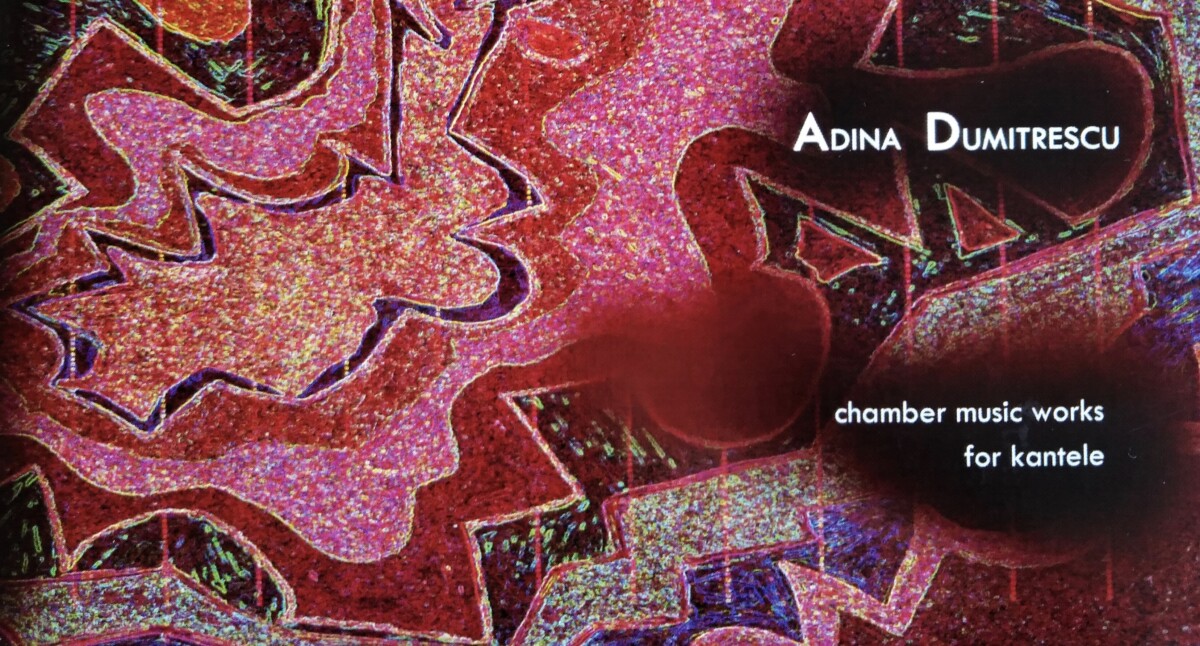New Works by Adina Dumitrescu
by Drew Wilson
Adina Dumitrescu’s new release of music for kantele has a richness of colour and invention which is well-matched by the composer’s own cover drawing. Around lines representing the strings of the kantele, one guesses, spread patterns and colours of the kind you get when you close your eyes against the sun, so that strange bewitching shapes spread under the eyelids like figures in a kaleidoscope.
‘Fresh’, the name of the first piece, could well be the title for the whole album. This is no pale evocation of a folkloric never-never-land, instead we get wit and a play of sonorities which sound almost electronic at times, at others fluid, dry, percussive, saturated or bell-like. The music to me suggests chthonic rituals with drums and tribal grunts, so I guess you could say Adina Dumitrescu’s use of the kantele is folkloric in that sense. If so, for all that, it is anything but limply nostalgic. I had always thought of the kantele as a rather fay instrument – my mistake; if there are any fairies about, these are not to be messed with, and possibly have scary tempers; the drums emphasise percussive moments when the hammers strike the strings en masse, moments which leave the ears tingling as if they’ve just been boxed, or as if you’ve been douched with a bucketful of exhilaratingly cold water.
Drums in track 1 give way to the gongs of the next piece, Acrilic, damunt tela (the title refers to the art of Joan Miro).These too bring out unsuspected depths from the kantele’s own sound. In this case, it is the richness of overtones, their lingering, echoing afterglow, especially as you hear the interference of diminishing waves between the various tunings.
There was a ritualistic element in ‘Fresh’; in Pas de deux: discussion on the way home, bass clarinet and kantele, this becomes explicit psychological theatre. If you are looking for wit, this is where you will find it nearest the surface. It is a conversation in which the two interlocutors seem to be quite at cross-purposes. The kantele speaks in one idiom, phrases following the logic of tonality, the clarinet interjects as if in another language. No understanding appears to be reached, and the sudden end has an anecdotal quality as we hear the running steps of one of the interlocutors making a dash for the door.
Glissandi are the telling feature of the two Apollinaire settings, suggesting dreams and water, the sinkings of melancholy hearts, the slippages of consciousness – possibly sanity too – in Clothilde’s fascination with numinous, erotic hauntings (this can hardly be the eponymous saint), a garden at night in which she imagines the presence of gods, the water pouring out of their hair.
In Le Pont Mirabeau, the glissandi and insecure tunings suggest an even more unhinged case, the deserted lover’s unhealthy fascination with the Seine flowing under its arches. It sounds dazed, a little punch-drunk, drowned in obsessive grief, the ever returning thought that love will never return. For even the most grief-stricken state has creative possibilities. Surrealism is only an affectation of madness, one fully aware of the saving grace of art. Which artist worthy of the name can suffer without thinking ‘I can get a good poem out of this.’ Or a good piece of music…
The short final sequence, Tuned to the Real World, can be linked to the other work on the CD I have not yet mentioned, Ua hoi! These pieces explore the exotic potential for variable tunings offered by the kantele. In Ua hoi! two kanteles contrast diatonic and microtonal tuning. Tuned to the Real World uses the tuning possibilities offered by a trio of instruments, and is lexicon of advanced compositional and kantele technique, exploiting consonance, dissonance and all the shades between, strings sustained and damped, metallic and bell-like, stable and fluid. After listening to the Apollinaire, one might think it could equally be called Tuned to the Surreal World. But in fact, the alternative reality evoked here is one which, in a parallel universe, could well have evolved from the microtonal theories underlying certain systems of tuning in the Renaissance and early Baroque. The kantele is an ideal instrument for such creative forays, given the ready accuracy with which each instrument can be retuned.
Such intriguing details can be gleaned from the very informative booklet accompanying the CD, to consult which increases one’s appreciation of the ingenuity of the music, though it can be wholly admired and appreciated without.
The author is an English composer and journalist
A Fresh Look at the Kantele -cd was released in 2015 by Inkoon Musiikki.
